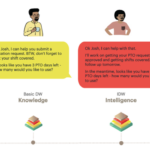post
December 20, 2021
What Are The Terms For An Intelligent Ecosystem?
It’s useful to become familiar with the terms surrounding intelligent automation.
As should be expected with a complex set of emergent technologies, there aren’t universally agreed upon terms or definitions used to describe intelligent automation. We’re not trying to dictate what’s right or wrong, we’re simply explaining what we mean when we say what we say. It’s important to remember that the definitions we provide below are specific to the context of the automated technologies and the ecosystems they operate within. Ideally, we’d use a term like intelligent hyperautomation.
Intelligent Automation
This term refers to automations that continually improve without human intervention using machine learning. True self-driving cars, while in their infancy, are an example of intelligent automation. If an OS can sequence the many different technologies required to drive a car, drive that car safely, and continue to improve its ability to drive, that’s intelligent automation.
Hyperautomation
When intelligent automation is regularly taking place within an ecosystem of orchestrated technologies, an organization is hyperautomating. This puts them in a position to quickly identify, vet, and automate business and IT processes at scale, providing an outsized advantage over competitors. There is a fair amount of interchangeability in the way hyperautomation and intelligent automation are talked about in the world (you can go ahead and add conversational AI, artificial intelligence, and robotic process automation to this tangle of terms).
Ecosystem
An ecosystem refers to all of the technologies and the parts of an organization that are relevant to conversational technology, and the sum of those parts. In other words, an ecosystem is an organization’s complete network of interdependent technologies, processes, and people. Even if you’ve taken no steps toward hyperautomation, your organization still has an ecosystem. Within an intelligent ecosystem built for hyperautomation, these elements are coordinated to enable, support, manage, facilitate, and benefit from the implementation of conversational AI.
Intelligent Digital Worker (IDW)
Think of an Intelligent Digital Worker as a peer to a human. In computer reality, an IDW is a collection of skills (as pictured above), analogous to a folder holding files or a domain name housing web pages. Ultimately, it’s objective is to take on some of the tasks that humans typically perform. IDWs can also be thought of as bots operating in coordination with one another and humans across your ecosystem.
Core Functions
Core function is a general term for an IDW’s primary purpose or deepest skillset. The core function isn’t necessarily the only thing an IDW will be capable of doing, but it does represent its primary function.
Primary Skills
Primary skills are critical to the way humans interface with IDWs and the ecosystem at-large. When mapping primary skills to our human experience, they are often analogous to necessary skills that we take for granted. For example, It would be reasonable to ask a design job candidate if they’ve used software like Sketch or InDesign, but you likely wouldn’t ask about their ability to ask another human when they need help, or if they have a track record of being able to respond accordingly over phone calls, text messages, and emails.
For an IDW, primary skills can look like this:
- Being able to operate over specific communication channels, like Slack, phone, google home, SMS, etc.
- Understanding natural language
- Including a human-in-the-loop when help is needed
Tasks
For an IDW, a task is the act of performing or applying a skill or skills in order to get something done. A task could be anything from authenticating a user to asking a human for help with a stalled process.
Skills
More broad than primary skills, these could include changing a password, managing an appointment or getting status on a project. Skills are the ability to do something, and are like the DNA of an intelligent digital ecosystem, sequenced to hyperautomate your company. They are the blueprint of what your ecosystem will be and what it will accomplish.
Flows
A flow is the sequencing of skills or steps that are used to execute a task. These are the patterns or instructions IDWs rely on in order to get something done.
Steps
A step is an instance of technology (or technologies) that can be sequenced in a flow, like ingredients in a recipe. Steps are like the protein sequences in our DNA. For example, a step could make an API call to a payment gateway in order to retrieve the last four digits of a customer’s most recently used payment method.
Human-in-the-Loop
We’ll be talking about human-in-the-loop often, and often from different perspectives. Fundamentally, it’s a human monitoring live conversations and interjecting when needed. Human-in-the-loop can refer to a tool or a person, and it’s integral to the design and development of your ecosystem. What’s important to understand heading into this journey is that the humans within your organization are crucial to your success. They provide an intimate understanding of the various tasks that will be automated. Their knowledge is used to design the IDWs and also to evolve them. As the IDWs perform tasks, they can turn to a human-in-the-loop when they get stuck or have questions about a step. Over the course of these interactions, the IDW learns more about individual problems and the different contexts they can appear in. The relationship that develops between IDWs and humans-in-the-loop is the fertilizer that accelerates the evolution and growth of your ecosystem.
Mapping these terms to the human experience is helpful when building familiarity, but there are clear differences. Data, information, and skills within an ecosystem can be shared between IDWs with a degree of efficiency and transferability that humans haven’t figured out yet. Imagine being able to instantly know how to build a fence because your neighbor, Sally, builds them for a living, and can transfer her skills and data through some osmotic process. That’s essentially the way information transfers between IDWs. If one IDW in an ecosystem knows how to do something, they can all know how to do it, just by knowing Sally one minute, you could have 1,000,000 Sally’s building fences the next.
Now that you have an understanding of the key terms we’ll be using, let’s unpack the conceptual and practical elements. A basic familiarity with the conceptual models of content strategy, or content strategy for websites and brands, can be a helpful foundation for understanding what it means to build a strategy for an ecosystem of intelligent digital workers.
We’ve identified four evolutionary phases that an IDW can move through as it becomes better at completing tasks. The lines where one phase ends and the next starts aren’t clearly defined, but understanding the primary characteristic of each phase can help you to estimate which one you’re in. All skills employ each of the described characteristics, but simple skills use them to a lesser degree, and more evolved skills use them to a greater degree. The experience most users have when interacting with skills and IDWs tends to reveal the primary characteristics of which evolutionary phase the skill or IDW inhabits.
As IDWs gain wisdom, friction begins to disappear for the user, but it’s important to remember that the evolution of the end user’s experience has an inverse relationship to the amount of orchestration required behind the scenes. Creating IDWs is really a matter of providing simplicity for users by finding ways to solve increasingly complex problems within your ecosystem.
Data and Information Literacy
Consuming and transforming numbers and characters into information. This can be either raw data, like an integer that can be decoded into a date, or the formatted version of that integer into a date (e.g. 01-01-2020). We often refer to this phase as a Primitive Digital Worker.
Knowledge
Understanding the context for information—knowing how and why information matters. This would be placing a date into context, like a DOB, for example. We think of this as a Basic Intelligent Digital Worker.
Intelligence
Knowing how to use or act on knowledge and information is the hallmark of an intelligent digital worker that is ready to function in an ecosystem. Understanding the relevance of the date of birth in different contexts, like: “I hope you have a great 21st tomorrow!” or “I got you covered! I just sent you an Uber gift certificate for your 21st”. This is an Intelligent Digital Worker.
Wisdom
Using the richness of experience to inform a decision. As IDWs develop the ability to tailor solutions to individuals based on the context of past interactions and stored data, they become more like a personal assistant, adding exponential value to their users and the organization. “Happy birthday! I see you’ve got dinner plans tonight and a workout class scheduled in the morning. If you think you might be out celebrating late, I can cancel the class for you.” Here we have a Personal Intelligent Digital Worker.
Stay up to date
Latest Articles



